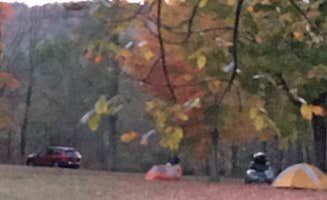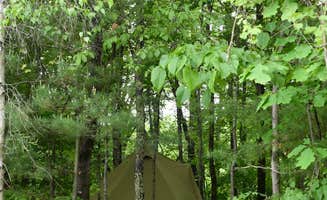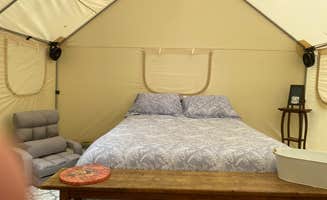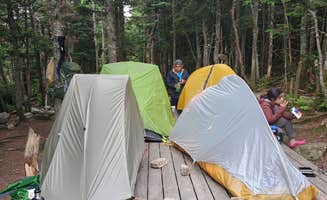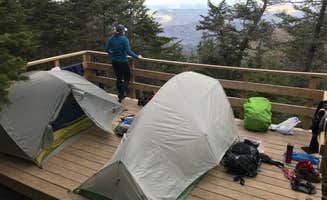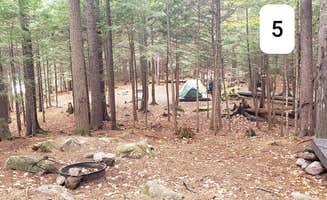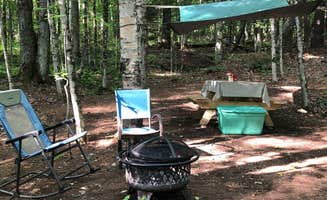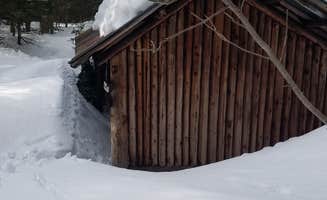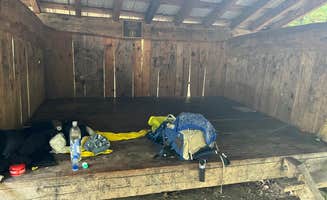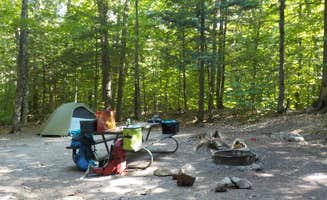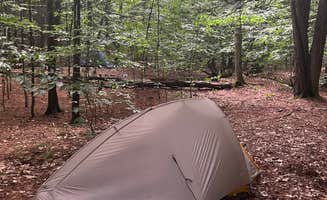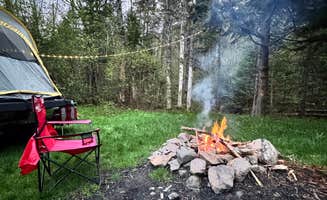Tent camping near Glencliff, New Hampshire offers access to the White Mountain National Forest at elevations ranging from 1,000 to 4,500 feet. The region experiences wide temperature fluctuations, with summer days reaching 80°F while dropping to 40°F at night at higher elevations. Weather patterns shift quickly in these mountains, particularly on exposed ridges where afternoon thunderstorms develop with little warning.
What to do
Mountain peak exploration: Rogers Ledge provides challenging hiking terrain with a vertical scramble to the summit that rewards hikers with Presidential Range views. According to a camper, "the trail climbs out of the campsite and eventually becomes a bit of a vertical scramble to the top. On a clear day you can see the Presidential Range easily."
Fishing opportunities: Baker Rocks has direct access to the Baker River with fishing spots along shoreline areas. A visitor noted, "I tent camped here while doing some fishing in the area... Along another bend of the river were two chairs for taking in the scenery. I only caught a few minnows when fishing but that may have been more to do with the angler."
Sunrise viewing: Higher elevation sites like Guyot Shelter offer unique opportunities for early morning views. One camper recommends, "There is a small stream to pump water from but it is seasonal. I highly suggest a sunrise peak if you have the energy to get up early!"
Swimming access: Several campgrounds feature water access for summer swimming. During warmer months, the ponds and streams reach comfortable temperatures for wading and swimming, though water quality varies significantly after heavy rainfall.
What campers like
Secluded tent platforms: Sawyer Pond offers tent platforms large enough for multiple tents with privacy from neighboring sites. A visitor explains, "Sites have platforms large enough to accommodate two free standing 2-4 person tents, depending on size and style. Each site also has a fire ring and there is plenty of dead and downed wood."
Communal areas: Many backcountry sites feature shared cooking spaces that foster community among hikers. At Garfield Ridge, a camper noted, "Large eating area. Great water source. Clean privy. Helpful staff. Approx 6 platform sites and shelter."
Night sky viewing: Remote sites without light pollution provide exceptional stargazing. One camper at Sawyer Pond shared, "The pond is gorgeous and the stars were AMAZING. You do have to forage for firewood, which can be rough, but there's a fire pit right in front of the lean to. I've never seen stars like I did here."
Varied accommodations: The best tent camping near Glencliff includes options beyond traditional tent sites. A visitor to Baker Rocks appreciated that "Baker Rocks had a host of different camping options onsite including tent platforms, yurts, and cabins."
What you should know
Limited firewood: Many backcountry sites require gathering wood from surrounding forests. A Sawyer Pond camper observed, "there was very little available firewood near the campsites," suggesting campers bring compact saws for processing downed wood.
Site availability challenges: Due to popularity, arriving early is essential at most locations. A Sawyer Pond visitor warned, "Due to the site's popularity, plan accordingly. Have a back-up plan for an alternate camping location. We witnessed several parties, many with young children, arriving late to find that all the sites were occupied."
Weather preparedness: Mountain sites experience rapid weather changes requiring appropriate gear. At Liberty Springs, "Located just off of Franconia Ridge, a great basecamp for anyone doing the ridge or a pemi loop... Gets packed on weekends."
Water sourcing: Water availability varies significantly by season. At Garfield Ridge Campsite, "Water is pump-able at the intersection to the tent-sites... A cooking area is provided. Bear boxes are right next to the cooking area for overnight use."
Tips for camping with families
Short hike options: For families with younger children, select sites with easier access trails. A camper recommended Sawyer Pond because "This is a great beginner backpacking trip, great even for kids! The site has one shelter and 6 campsites available on the bank of Sawyer Pond."
Educational wildlife opportunities: The northern White Mountains contain prime moose habitat. Near Rogers Ledge, a visitor noted, "A gradual climb from the trail head to the campsite through a few boggy areas before climbing into the boreal forest for a bit. Prime moose habitat!"
Seasonal planning: Different seasons offer unique family experiences. One camper shared, "Sawyer Pond was my introduction to backpacking more than 40 years ago... It's a nice snowshoe hike in winter. I've ice-fished on the pond."
Alternative lodging: For families not ready for tent camping, consider mixed accommodations. A visitor to Baker Rocks shared, "We stayed 2 nights in the double bell tent with two clean full size beds and a 3rd night in the yurt both were spacious and wonderful, among tall trees and pines."
Tips from RVers
Base camp strategy: RVers can use established campgrounds as base camps for backcountry day hikes. Since many forest roads are unsuitable for large vehicles, smaller motorized transportation for trail access becomes essential.
Site selection for truck campers: Smaller truck campers and campervans can access some trailheads that full-size RVs cannot. At Trapper John Backcountry Campground, "The trail head is located at the end of a 9 mile road and there are several spots for parking- note: there is no cell service once you get on this road."
Weather monitoring: Mountain weather creates challenging road conditions. Forest service roads often close seasonally due to snow, mud, or washouts, requiring flexible planning and regular condition checks before travel.


